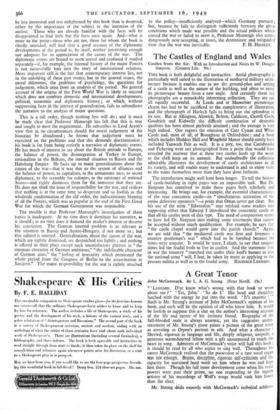The Castles of England and Wales
Castles from the Air. With an Introduction and Notes by W. Douglas Simpson. (Country Life. 30s.) THIS book is both delightful and instructive. Aerial photography is particularly well suited to the illustration of mediaeval military archi- tecture because. it enables one to see the ground-plan and setting of a castle as well as the nature of the building, and often to enjoy its picturesque beauty from a new angle. And certainly these rt2 photographs are a remarkably interesting collection. They are not all equally successful. At Leeds and at Manorbier picturesque charm has had to be sacrificed to the completeness of illustration, and the photograph of Harlech fails to bring out the splendour of its site. But at Allington, Alnwick, Bolton, Caldicott, Castell Goch, Goodrich and Kidwelly the difficult combination of desirable qualities has been almost perfectly attained ; and the average is very high indeed. One regrets the omission of Caer Cynan and White Castle and, most of all, of Broughton in Oxfordshire ; and a book which includes Haddon Hall and Wingfield Manor should surely have included Yanwath Pele as well. It is a pity, too, that Carisbrooke and Pickering were not photographed from a point that would have revealed the stairway that at these two castles leads up the mom to the shell keels on its summit. But undoubtedly the collection admirably illustrates the development of castle architecture in all its variety, and will enable many to undertand it and to enjoy visits to the ruins themselves more than they have done hitherto.
The introduction might well have been longer. To tell the history of castle-building in eight pages was an impossible task. But Dr. Simpson has contrived to make those pages both scholarly and interesting. He brings out, for example, the essential characteristics of the true concentric castle—its " simultaneous activation of the entire defensive resources "—a point that Oman never got clear. But his use of the term "Edwardian" may mislead some readers into supposing either that Edward I introduced the concentric castle or that all his castles were of this type. The need of compression seems to have led Dr. Simpson into making some statements that cannot be accepted without much qualification. For example, he says that " the castle chapel would grow into the parish church." Again, we are told that " the mediaeval castle was first and foremost a country gentleman's seat " which had to be fortified because the times were unquiet. It would be truer, I think, to say that unquiet times led the feudal lords to live in castles. And the statement that in war the tenantry " marched out under their lord's banner to join the national army " will, I fear, be taken by many as applying to the peasant militia as well as to the feudal army. REGINALD LEONARD.


































 Previous page
Previous page